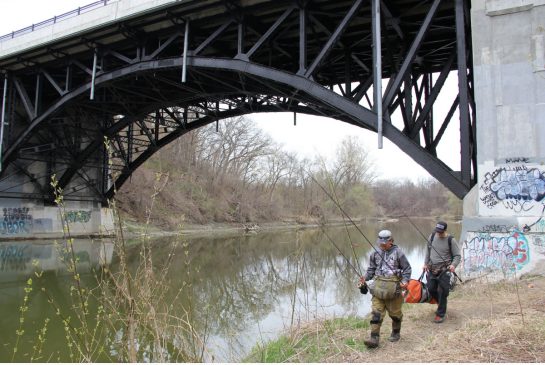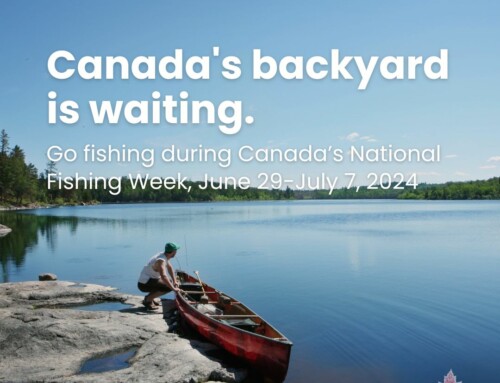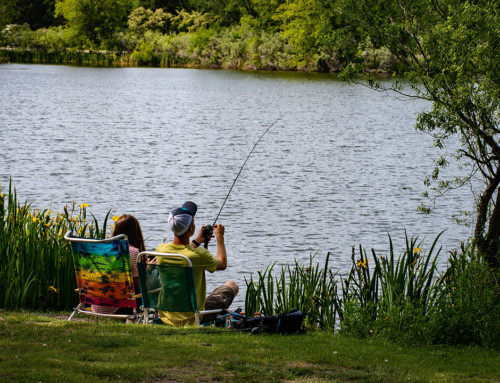Originally Published by the Toronto Star, May 22, 2015
By Daniel Otis
Wearing waders, Matthew Saieva stands knee-deep in the Humber River gracefully casting a homemade fly into a pool under the 99-year-old Old Mill Bridge. Bands of gold shout through the grey dawn. A cormorant bobs on the cool, shallow water. The nearby tennis courts are vacant and the river’s muddy banks are dotted with footprints: raccoons, ducks, herons and rubber boots.
“When I’m fishing, my mind is blank,” says the 20-year-old Toronto angler. “I’m not thinking about anything. It’s very soothing. It’s very good stress-relief.”
It’s a perfect escape from his hectic family home and the pressures of university.
I’m joining Saieva and David Clark to fish for a Toronto trout to eat. The Ministry of the Environment and Climate Change’s Guide to Eating Ontario Fish states most of the city’s fish are safe to eat. I can’t help but find that a little surprising.
Toronto’s rivers and lake don’t exactly conjure up images of aquatic delicacies. Growing up in the city, I shared the prevailing urban opinion that Lake Ontario and its tributaries were as filthy as waterways could be. While this was more-or-less true when my folks were young in the 1950s and ’60s, contaminant levels have since declined. Still, many of my millennial friends won’t touch the lake. But in light of the province’s guidelines, I’ve decided that I want to try a Toronto fish.
Saieva and Clark spend a lot of time fishing in the city. Both are members of the Toronto Urban Fishing Ambassadors, or TUFA, a collective of urban anglers who educate, advocate and regularly host waterfront cleanups and family fishing events. They agree to help me on my mission.
Clark co-founded TUFA in 2012 in response to the Harbourfront Centre’s attempt to ban shore fishing along its expansive lakefront property.
With the help of city councillor (open Paula Fletcher’s policard)Paula Fletcher (open Paula Fletcher’s policard), TUFA successfully fought the ban early that summer.
“The fishing ban was one of the best things that happened here because it solidified the anglers,” Clark says. “People suddenly realized there were fish here because it got so much publicity!”
Clark says the best places to fish are the Toronto Islands, Tommy Thompson Park, the Scarborough Bluffs, Toronto’s waterfront and the Don and Humber rivers. Trout, salmon, bass, carp, pike and perch can all be found.
“Most people in Toronto can’t afford to have a family cottage like they did when I grew up,” Clark says. “But you can go fishing right here in the city and enjoy the parks.”
Clark takes the TTC from his tackle-cluttered apartment at Queen St. W. and Spadina Ave. to meet me at the Old Mill subway station at 6 a.m. on a Friday in early May. Doorstep fishing, he says. It couldn’t be easier.
He comes armed with rods, tackle and a pair of waders — rubberized overalls attached to boots. He wears a TUFA cap low over his eyes and gets animated when we talk about fish — which is most of the time.
Clark spent a long night bussing tables and washing dishes at a downtown pub. He didn’t finish work until 4 a.m., but shrugs off my suggestion that he get some sleep.
“Originally it was for relaxation and to get engaged outside with the natural world,” he says of fishing in Toronto. “It’s become — now with Toronto Urban Fishing Ambassadors — a way to give back to the city that has given me an awful lot.”
Raised in Peterborough, Clark has been fishing since the age of five. He has lived and fished Toronto’s waters for the past three decades.
A half-dozen fisherman are within eyeshot when we arrive where the Humber River runs under the Old Mill Bridge, just 500 metres from the station.
Saieva is already there.
“I like being on the river, just exploring,” says Saieva, a Toronto-native, whose first fished at a family cottage at the age of two. “Everyone nowadays — even my friends — they’re all stuck with technology. We need more people to go outside and actually enjoy the outdoors.”
There’s a sincere childishness to his laugh, which seems incongruous with his long ponytail and short goatee. He wears a diamond stud in his left earlobe and a hoodie adorned with a rainbow trout. Saieva fishes year-round and a few times a week.
Clark wastes no time getting started. He rigs up spinning tackle with a weight and live worms.
“I usually don’t eat what I catch,” he says. “We generally like to promote catch and release.”
Saieva agrees — he only eats about one catch a year — but they both decide to humour me. Saieva’s setup is more elaborate than Clark’s — he uses colourful homemade flies, bundles of fish eggs, worms and multicoloured plastic beads that resemble roe. When he’s not in his environmental sciences classes at York University, Saieva sells his insect- and egglike creations through his online company, Kypefish Quality Flies.
Clark shows me how he rips a worm in half and hooks it. I borrow his waders and enter the river. Birds sing and flit in the trees. I cast. A trout jumps and splashes upstream.
Clark tells me about the time he saw a mature buck grazing along the banks of the Humber, just south of Bloor St., close to where we are now.
“It just floored me.”
An hour passes. The waders leak. Tiny fish nibble the bait off my hook a few times before I finally get a bite. I reel to disappointment. I’ve hooked an ugly little goby: an invasive species believed to have been brought to the Great Lakes in ballast water from Eastern European cargo ships. Clark says it’s illegal to throw it back or use it as bait. We leave it on a rock to die.
“A seagull will eat it,” he says.
Clark, Saieva and I try different spots along the river, passing graffiti-tagged bridges, the subway rumbling above. We see a raccoon scampering on the eastern bank, a mink slipping into the water.
When we go back to the Old Mill Bridge, Clark and Saieva both land several White suckers — a common fleshy-lipped bottom feeder. Clark says they’re good eating, but I’m set on a Toronto trout.
By 10 a.m., most of the other anglers are gone. The sun illuminates the water. Fish are supposed to be active in the cool early morning, but defying fisherman logic, this is when the trout start biting.
Saieva lands a small silvery rainbow trout. He decides to give the fish a chance to grow into a proper dinner.
I catch my second and last fish — a little glittering chub that’s only a fraction of the size of my hand.
“You finally got a real one,” Clark grins as I release it.
A gull dives into the water nearby, catching a chub too.
“Everybody’s catching fish!” Clark says.
On one of his last casts of the day, Saieva hooks the Big One.
He reels. The fish fights. Saieva’s rod bends. Fearing the line will snap, he attempts to tire the fish out.
“I think she’s hooked in the tail,” he shouts as they fight. Only fish hooked in the mouth are legal to keep.
Saieva manages to get the 2.5kg fish in the shallows before grabbing it.
“She’s fresh from the lake,” he says before releasing her. She had been travelling upstream to lay her eggs.
By noon, we’re done. Clark needs to rest before his 5 p.m. shift and Saieva plans to meet a friend. We carry our gear on to the subway. There’s something delightfully incongruous about riding public transit with tackle and fishy smells on your fingers.
We get more than a few curious looks.
While the suckers we caught are decent eating, I had my heart set on a Toronto trout, so Clark put a call out on TUFA’s 500-plus member Facebook group and local angler Colin Hatcher offered up a 2.5kg fish he caught that same morning, slightly south of where we fished near the Toronto Humber Yacht Club.
The province’s Guide to Eating Ontario Fish recommends no more than one meal per month of a Humber rainbow trout this size. Because children under 15 and women of child-bearing age are more sensitive to potential contaminants, the guide recommends that they eat none. By comparison, anyone can enjoy eight trout this size caught near Thunder Bay. With this in mind, I eye Hatcher’s catch.
Hatcher, who runs a small catering business, was born and raised near the Humber and has been angling since the age of four. He still lives a short walk from the river and goes fishing every chance he gets. He says he eats a river trout every month.
“They have way more flavour than store-bought trout,” he says. When asked if he’s concerned about contaminants, he replies, “No, not really.”
Hatcher brings the gutted trout into the Star’s test kitchen to cook. He removes its fins and belly fat before carving a fillet. To assess the fish’s health, he checks the fillet for blood spots and bruises. He finds none.
“Looks like it’s going to be a good one.”
He sprinkles the fillet with sea salt and black pepper and sears it in olive oil for a few seconds in a cast iron pan. With the skin facing downwards, he transfers the pan into an oven preheated to 380°F. The fish bakes for 10 minutes and is served with a sauce made from melted butter, garlic, lemon juice, olive oil, and dashes of oregano and parsley.
“Don’t eat the skin,” Hatcher warns. “Toxins.”
I find the fillet tasteless and a little rubbery. At least the butter sauce redeems it. I chew slowly, deliberately.
“It’s fine,” I tell myself. I force a swallow. I think about toxins. I imagine this trout living its fishy life dodging plastic bags and sunken tires. I know the fish is OK, but I can’t shake the stigma. I am happier not knowing where my dinner came from.
You can actually eat Toronto’s fish
Toronto’s fish are (mostly) safe to eat, says Dr. Satyendra Bhavsar, a Toronto-based research scientist with the Ministry of the Environment and Climate Change who specializes in monitoring contaminants in Ontario’s fish.
Whether or not a fish is safe to eat largely depends on the species, its size and where it was caught, Bhavsar says. As a rough rule, the bigger the fish and/or the higher on the food chain, the greater the potential contamination.
The primary contaminants affecting fish in the GTA are polychlorinated biphenyls, or PCBs: a highly toxic family of chemicals that were once extensively used in manufacturing electrical equipment. PCBs have been link to cancer and developmental disabilities and were banned in Canada in 1977. Releasing such chemicals into the environment was made illegal in 1985. but PCBs still linger in the waterways, accumulating in fishes’ fatty tissue, they are particularly prevalent in fatty fishes, such as salmon and trout.
“Overall, there have been significant declines in PCB levels in fish from GTA tributaries and the Toronto waterfront, which makes the fish much safer to eat now than 40 years ago,” says Bhavsar, an occasional GTA angler and fish-eater. Those PCB levels have declined by more than 90% in several species and waterways, the scientist says. “Fish in the Toronto waterfront area are more or less safe to eat, provided that you follow the consumption advice.”
That advice is laid out in the ministry’s biennial Guide to Eating Ontario Fish. By measuring contaminant levels in different species at more than 2,300 locations province-wide, the guide provides site-specific recommendations about how many fish meals per month you can safely eat.
Bhavsar says trash-strewn urban waterways are not necessarily more tainted than those in other parts of the province. PCBs, mercury and many pesticides are invisible to the naked eye and contaminants can be naturally occurring.
“In many cases, actually, advisories are more restrictive for remote locations than for GTA water bodies, and this is largely a result of mercury that can be naturally present and can be found at higher levels in the Canadian Shield area.”
An interactive version of the guide is available at Ontario.ca/fishguide.
Photo courtesy of Daniel Otis/ Toronto Star







